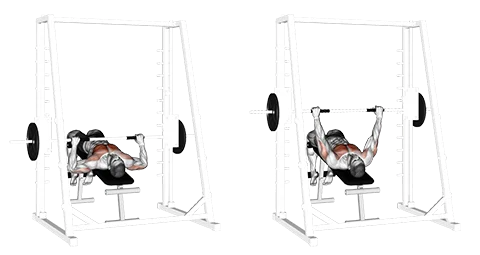Introduction
The Decline Smith Machine Bench Press is a resistance exercise that targets the chest muscles, particularly the lower portion, while engaging the triceps as well. It's beneficial for building strength in these areas and enhancing overall upper body definition. This exercise is effective for those seeking to build a balanced physique or focus on developing the lower chest due to its unique decline position compared to traditional bench presses.
Muscles Worked
- Primary: Chest (Pectoralis Major), Triceps (Triceps Brachii)
- Secondary: Shoulders (Deltoids), Core (Rectus Abdominis, Transverse Abdominis)
How to Do It (Step-by-Step)
- Stand in front of a Smith Machine with your feet hip-width apart and shoulder-width under the barbell. Grab the barbell slightly wider than shoulder-width using an overhand grip.
- Unrack the barbell by lifting it off the pins while maintaining a tight core, keeping your back straight, and ensuring the barbell is directly over your midfoot.
- Lower the barbell in a controlled manner until it touches your upper chest or lower part of your chest, keeping your elbows tucked in throughout the movement for stability. Exhale as you push the barbell back to the starting position, keeping your core tight and maintaining good posture.
Tip: Keep your head in a neutral position and avoid jerking or bouncing the barbell off your chest for maximum safety and effectiveness.
Rep & Rest Guidelines
- Strength: 4–6 reps, 2–3 min rest
- Hypertrophy: 8–12 reps, 60–90 sec rest
- Endurance: 12–20 reps, 30–60 sec rest
Use Auto Progression to automatically adjust your weights for optimal progression.
Track and optimize your rest times with the Rest Timer.
Form Tips
- Maintain a neutral grip on the barbell (shoulder width apart or slightly wider) to reduce strain on your shoulders.
- Keep your back flat against the Smith Machine pad and your feet firmly planted on the floor for stability during the exercise.
- Lower the bar slowly and controlled, bringing it down until it touches your chest, and then push it back up in a steady motion. Avoid bouncing the bar off your chest or using momentum to lift it.
When to Use It
- Strengthening Upper Chest: The decline Smith machine bench press targets the lower portion of your chest muscles, making it ideal for developing a balanced and well-defined upper body.
- Enhancing Lean Muscle Growth: Performing decline Smith machine presses can effectively stimulate muscle fibers to grow due to the increased range of motion compared to traditional flat or incline bench presses.
- Increasing Core Engagement: By adjusting the bench to a decline position, the Smith machine bench press places additional emphasis on your core muscles, helping you build a stronger midsection while working your chest.
Workout History allows you to track and analyze your progress over time for optimized fitness results.
The decline position targets lower pectoral muscles, enhancing overall chest development.
Start with a weight that allows for 10-12 reps per set to ensure proper form and gradual progress.
Use a shoulder-width grip to target the lower chest muscles effectively.
3-4 sets of 10-12 reps is a good starting point for most people, adjust based on your fitness level and goals.
Maintain a neutral spine during the exercise to avoid injuries and ensure proper muscle engagement.

